The Checker Maven
Our Northern Neighbor

The famed checker editor Manson D. Teetzel, whose career spanned decades of checker publishing, originally came from the town of West Lorne, in Elgin County, Ontario, Canada. No doubt "Teetzel" as he simply liked to call himself, would have been familiar with a scene similar to the one shown above, a beautiful photo of the Canadian shores of Lake Erie, not far from Mr. Teetzel's home town. (The photo is presented courtesy of photographer Rick Blaxall; more of Mr. Blaxall's work can be seen here.)
Teetzel later moved to the United States, where he published American Checker Monthly and for which he is probably best known. But while still in Ontario, he produced The Canadian Checker Player, and it's a problem from the latter journal that we present today. Teetzel didn't give an attribution for the problem; he simply set it forth, something over a century ago.
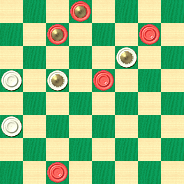
BLACK
Black to Play and Win
B:WK22,20,K19,12:BK31,K27,25,18,3.
Black is a man up, but that's about to change as White is going to even the tally on his next move. Yet Black can still win. Can you figure out how? You don't have to be Canadian to find the solution, you just have to be a Checker Player. Give it a try and then click on Read More to see the solution.![]()
Our Reasoning Powers
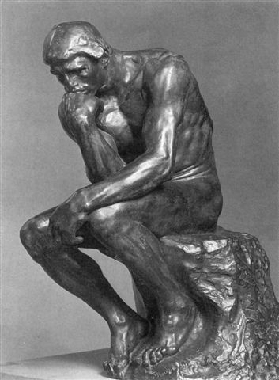
Certainly, the game of checkers is a great exercise of our thinking abilities and a terrific way to develop our reasoning powers. The problem shown below, based on a game played by 19th century checkerist J. P. Reed, will definitely stretch and grow your thinking and reasoning skills. It's this month's entry in our ongoing Checker School series, and comes from Ben Boland's classic work, Famous Positions in the Game of Checkers.
WHITE
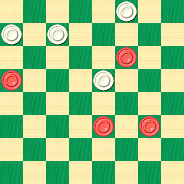
BLACK
Black to Play and Draw
B:W30,28,27,18:B22,20,10,9.
Black has a severely limited choice of moves, always a sign of trouble. Yet the position can be drawn, although that will require quite an application of our reasoning powers. Can you reason it out? Think it through, and then click on Read More to see the solution, a sample game, explanatory notes, and a special insert on reasoning powers in checkers.![]()
Sullivan's Catch
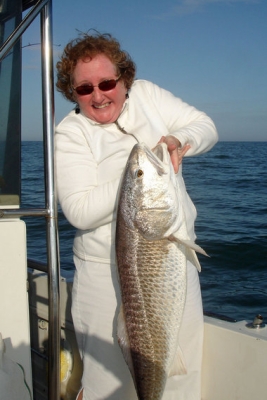
We're not certain that the happy lady shown above is named "Sullivan" --- though that's entirely possible --- but we're most sure that she's made quite a catch indeed, and we can appreciate why she's smiling so broadly.
Of course, the real question for us should be, "Does she play checkers?" and although that's another thing we can't know for sure, it's definitely within the realm of possibility.
Today's column, though, is about a different Sullivan and a different kind of catch, one that is just as tasty as the catch shown above. It comes from Willie Ryan's Tricks Traps and Shots of the Checkerboard, and Willie will tell us about it in his own words.
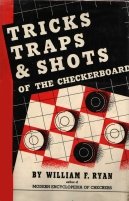
"When something new is found on an ancient opening like the Ayrshire Lassie, that's news. A few years ago, James Sullivan, a strong amateur from St. Louis, Missouri, hatched a new twist on the Ayrshire Lassie by 21-17 at the fourteenth move of the game below. He subsequently sprung it on Newell Banks and me, and, like two babes in the woods, we both fell for the sucker bait by 9-13 in reply. This trap is a 'natural,' and will catch even experienced players.
| 11-15 | 15-18---A | 11-18 |
| 24-20 | 22-15 | 21-17---1 |
| 8-11 | 11-18 | 9-13---B, 2, which |
| 28-24 | 26-22 | leads to the |
| 4-8 | 7-11 | diagrammed |
| 23-19 | 22-15 | placements. |
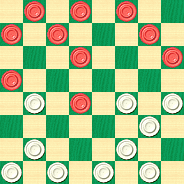
WHITE
White to Play, Black to Draw
W:W32,31,30,29,27,25,24,20,19,17:B18,13,12,10,8,6,5,3,2,1.
A---If you want a short, fast game, play 9-13. Your opponent, no doubt, will reply 20-16, 11-20, 22-17, 13-22, 25-4, winning fast and leaving you short.
B---Newell Banks and Author Ryan slept here! Of course, the trap that follows this move is best avoided, but 9-13 does not lose, as erroneously claimed by Sullivan. The safest course for black at B is: 18-23---2, 27-18, 9-14, 18-9, 5-21, 32-28,10-15,19-10, 6-15, 31-27, 8-11, 27-23, 1-6, 25-22, 3-7, 23-19, 6-10, 22-18, 15-22, 19-16, 12-19, 24-8, 10-14, 8-3, 7-10, 3-8, 14-18, 8-11, 18-23, etc., consummating a draw. Wm. F. Ryan."
1---30-26 or 32-28 would be much better here. While not calling this necessarily a loss, the computer deems 21-17 as quite poor, giving Black a solid advantage---Ed.
2---After 9-13, the game indeed evaluates as a draw. After 18-23, as recommended in Note B, the game also evaluates as a probable draw, as Willie demonstrates. However, the computer thinks the correct move is instead 9-14, which preserves Black's substantial advantage, for instance KingsRow gives 9-14 17-13 2-7 31-26 7-11 27-23 18x27 32x23 3-7 25-22 14-18 23x14 10x17 29-25 5-9 19-15 11x18 22x15 9-14 and White is all but lost---Ed.
Now, as you try to resolve this position, we feel it only far to warn you: Just as Willie missed a trick or two at Notes 1 and 2 above, he also misses a trick in his proposed solution. So in one sense, we're asking you to do a little better than Willie; that's quite a demand to make. But this problem is well worth your time. Can you "catch" the solution, or will it be the one that got away? When you're finished, hook your mouse on Read More to see some detailed analysis.![]()
Spring Into Spring When This One Springs

We always hear about "springing into spring" at this time of year, and the arrival of spring is always welcomed after a long winter. Shown above, though, is a spring of a different kind, and when this one springs, we think you'd better move fast and clear the area.
Moving fast and clearing the area--- on the checkerboard--- are our topics for today. We're doing something a little different; we're presenting a stroke problem as a speed problem. Unfair? How can you say such a thing! We're going to give you 60 seconds to solve this one; that's a whole minute!
When you're ready to spring into action, click on the link below--- and move fast. When you're done, spring your mouse on Read More to uncoil the solution.
April Stroke Problem (easy to moderate difficulty; 60 seconds)
![]()
